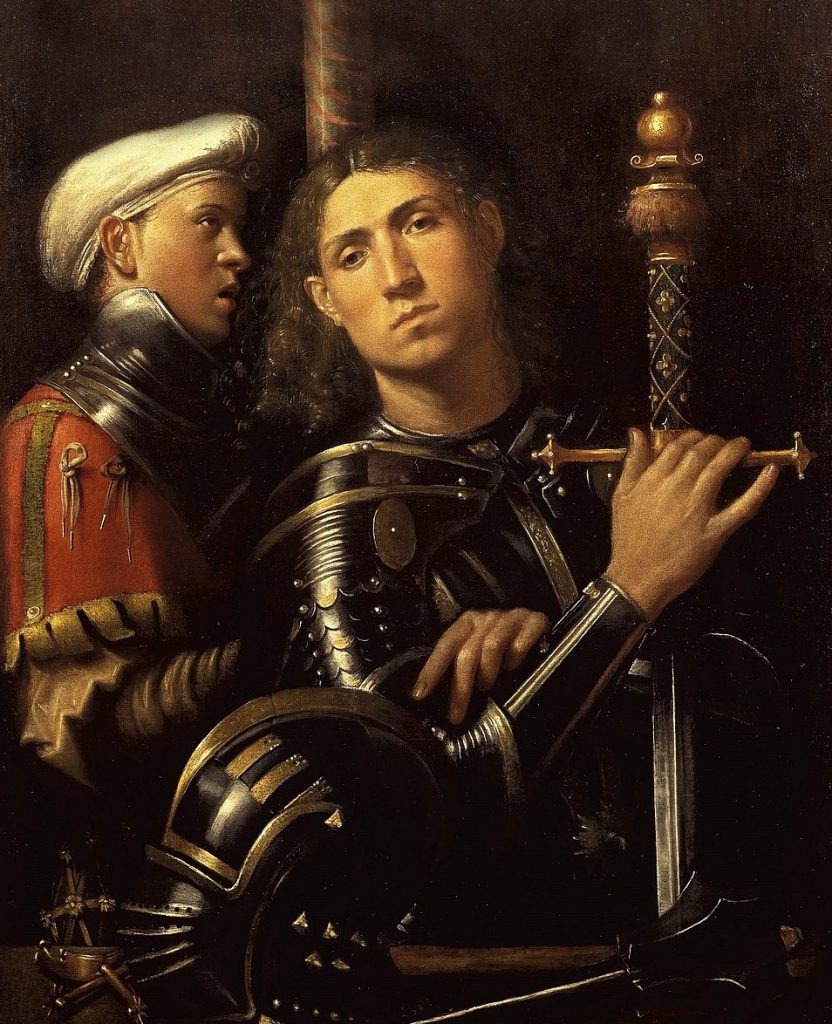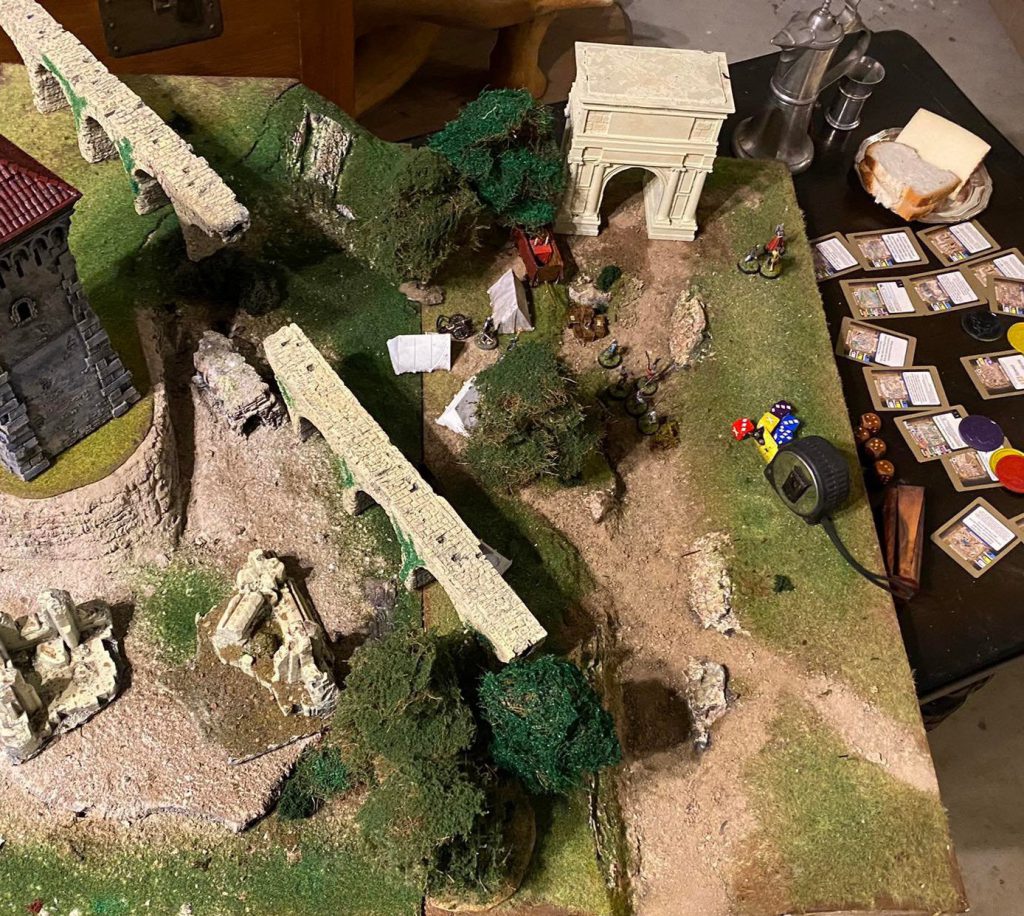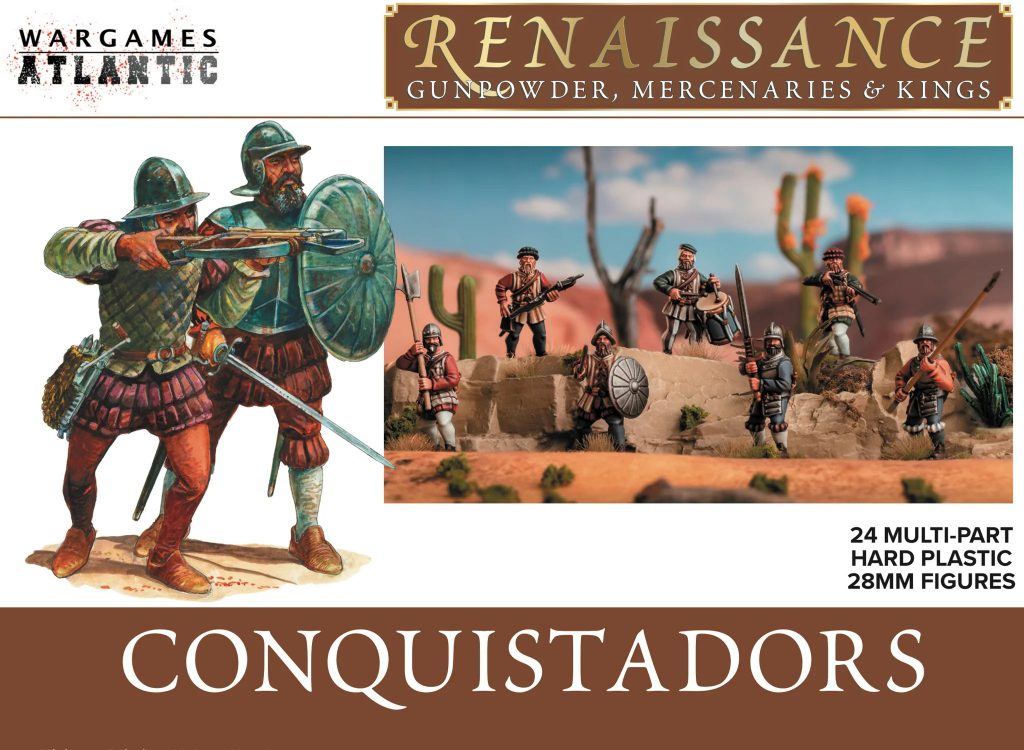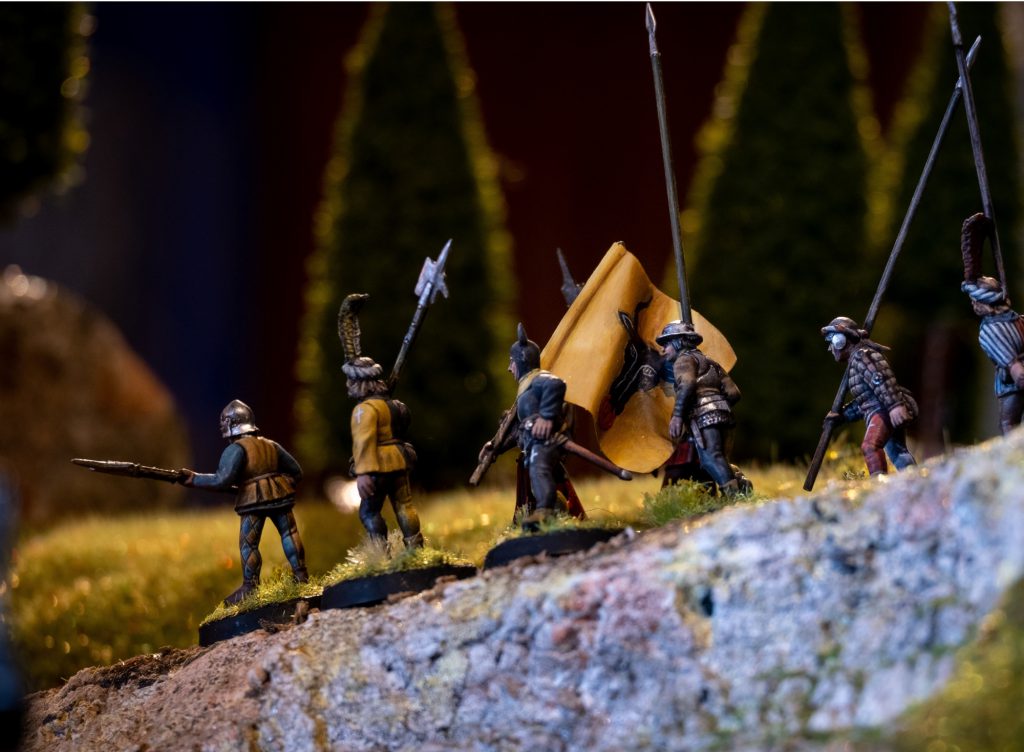For Americans, the year 1492 probably brings to mind a schoolroom ditty about oceans blue, but there was a lot more going on in the world than Columbus “discovering” the New World. Rodrigo Borgia has been elected as Pope Alexander VI and his children and political allies fight their way across Italy, taking what they can at the point of a sword, halberd, or lance. Swiss and German mercenaries (not to mention many other continental nations and city states) sell their skills to the highest bidder. The Ottoman Empire presses in from the east, a perpetual threat poised to render the machinations of European princelings meaningless as their armies and navies threaten to conquer all of Christendom.

This is the backdrop for Force of Virtue, a tabletop miniatures game by Masterstroke Games. The players will assemble a small band of mercenaries to further their goals in and around Rome, The Eternal City. These mercenaries will fight under the direction of Capos, loyal retainers who fight in the streets, alleys, sewers, and surrounding countryside to advance your political aims. But be wary, the loyalty of hired swords only extends so far, so if your Capos run out of the Virtue needed to lead them, they’ll seek to preserve their own skin and flee the fight.

What Do You Need to Play?
Force building is done by selecting cards from decks, and you are allowed to build from three decks (up to two of those can be nation decks). Nation decks provide troops, Capos (leaders) and national flavor through the form of specialized equipment, honors, and subterfuge.
Nation decks can be combined seamlessly to represent either a force of allied mercenaries from two nations, or mercenaries from one nation that have received training in the style of another nation. Character decks provide unique ethos that you can use to customize the feel of your force by giving your soldiers useful backgrounds, training, and temperaments by adding personality to your soldiers. Scenario decks provide setting-specific twists and allies that tie the game more deeply to a period and location.
At minimum you will need a copy of the rulebook and at least one nation deck. You will eventually want to own at least two nation decks and one of the character decks. Additionally, at least one player should own a copy of The Rise of the Borgia scenario deck.
The available nation decks are:
- Condottieri: outwit your opponent with subterfuge, strong knights, and skirmishers
- Swiss: grind your opponent into the dust with well-trained veteran troops
- Landksnecht: outperform your opponent with the best pike and shotte money can buy
- French: crush your opponent with chivalrous knights
- Spanish: show your opponent the might of the tercio with highly specialized, unique soldiers
The available character decks are:
- Born to Battle: virtuous combat
- Renaissance Man: science, medicine, engineering, and tactics
- Dogs of War: brutal acts of violence
- Fires of the Faith: boosting faith, rallying
The available scenario decks are:
- The Rise of the Borgia: useful for setting your games in Rome in 1492 when the Borgia family was expanding its powerbase through politicking and skullduggery.
- The Siege of Gradara: details to come with the release of the siege expansion.
The rulebook is available as a PDF for $8 from Masterstroke Games. Physical copies of the rulebook as well as the card decks are available from Masterstroke Games (Europe) and Phalanx Games & Sundry (USA). (Note: at the time of publication, Masterstroke Games has suspended restocking their web store in anticipation of fulfilling their Siege of Gradara KS pledges. Late pledges are still open if you’d like to order any current or upcoming product.)
Players need six to eight D6 dice in each of the colors that correspond to the four medieval virtues: red (audacity), yellow (speed), blue (prudence), and purple (fortitude). It is useful to have six additional dice of a different color for any dice rolls not tied to a specific virtue and for marking statuses like reload or free defense dice.
We’ve found that the game plays best on a 3’x3’ table, but anything from a 2’x2’ to a 4’x4’ works just fine. You will have the best experience on tables with fairly dense terrain. Ideally your terrain should include plenty of crumbling buildings, overgrown with vegetation to represent the abandoned neighborhoods of Rome’s former glory.
What Miniatures Should I Buy?
Your force will typically be made up of 1-16 miniatures. Depending on your chosen nation this will typically include 1-3 knights, a banner bearer, and a mix of unarmored or lightly armored troops with a mixture of pikes, halberds, sword and shield, crossbows, and arquebus. You typically get three troops per card, so it’s often convenient to plan your force around groups of three similarly equipped models.
If you’re interested in playing the Condottieri, Swiss, Landsknecht, or French, the Perry WR20 Plastic ‘Mercenaries’ box is an amazing value for getting into the game. It includes nearly all of the common weapons you could want as well as a few armored bodies to make your knights.
If you prefer metals, the Perry’s European Armies range is also an excellent entry point.
If you prefer a later “puff and slash” look for your Landsknecht, you may consider the Warlord Games Pike & Shotte range.

For the Spanish, it’s tough to beat the Wargames Atlantic Conquistadors box (our affiliate link).
Gameplay Overview
Your force is divided between basic troops and Capos, who serve as the commanders or lone wolf specialists. Additionally, you may upgrade your troops to veterans who can operate independently from the rest of the force without needing the oversight of a Capo.
Players alternate selecting Capos to give orders, such as move, shoot, reload, or fight. Orders may be given to any number of friendly troops or Capos within the Capo’s command range. When an order is given, the Capo issuing the order must choose to spend some of their virtue to give the order. While performing the ordered action the player rolls all of their virtue dice and chooses one of them to resolve the action. Since you get to choose which die is used to resolve the action, rolling more dice increases the chances of a favorable result while decreasing the chances of failure.
Troops and Capos have a limited number of Actions that they can perform in a round. They are also limited by their Faith, which determines how many Virtue dice they can activate with in a round. The most basic Mercenary troop has two Actions and three Faith, so they typically do two actions in a round, one with one die and one with two dice, though there are circumstances where putting all three dice into a single action that absolutely must succeed is worth doing.
Virtue rolls of a one result in special critical failure result and rolls of a six result in a special critical success result depending on which of the four virtues are being used for what action. The virtues are pulled directly from Fiore’s four virtues that an aspiring master swordsman would need to possess:
- Audacity: the action is done brashly, disheartening your opponent
- Fortitude: the action is done methodically, possibly at the expense of moving quickly
- Prudence: the action is done carefully, but be warned that sometimes it’s most prudent to run away
- Speed: the action is done swiftly, but possibly carelessly

Scenarios
Narrative scenarios are the heart and soul of a Game of Force of Virtue. The rulebook includes a series of charts you can roll on to randomize deployment, objective placement, and the narrative that drives the scenario.
As an example, in one game you may roll that you will lead an assault (the objective is hidden in one of 5 terrain pieces) against an advancing enemy (deploy on board edges) in order to blackmail an assassin and extort an enemy.
In another game you may roll that you will lead a strike (single central objective) against a scattered enemy (deploy in small groups around the board) in order to free the duke’s son and repay a debt.
Crucially, this means that you’re never just playing a game of “just kill the other dudes”. There’s always a deeper narrative thread that drives the game. The variety of objectives gives a great excuse to track down civilian figures to represent objective characters, such as the duke’s son, wealthy merchants, and so on.

Rome Awaits
Force of Virtue is worth checking out if you have even a passing interest in late medieval or early renaissance warfare and are interested in a skirmish game with a bit of tactical crunch. The game’s unique mechanics may take a game or two to wrap your head around, but you’ll discover that the game offers a gameplay experience with rich tactical depth that gives you many interesting choices and trade-offs over the course of a game.
The hobbying time required to get started is quite low – the ‘core’ of a force is around 13 miniatures (knight, banner, nine mercenaries with a mix of pike, halberd, and crossbows) but those same miniatures can be played in many different ways by selecting different upgrade cards.
The nation decks have 55 cards and the character decks have 27 cards with some repeated cards in each deck. For most games you’re building a force of 10-16 cards, giving you a nearly overwhelming number of different ways to build a force if you have just a few decks.
The cards feature period art and names that do a great job of evoking the setting as well. We’re fairly confident that no other game gives you the option of upgrading your mercenaries with the Writings of Seneca, Longbeards, or Symbol of True Faith. Similarly, where else can you upgrade a knight with things like It Is Not Titles That Honor Men, But Men That Honor Titles, Cruel Insanity, or That His Vengeance May Not Be Feared? Throw Copious Alcohol into your most Audacious Zweihander-wielding doppelsoldner weaving their Steel Web, and you’ll soon be paving the streets of the Eternal City with the blood of your enemies!
We’ve found that the cloak and dagger nature of the setting and randomized scenario design drive us toward playing creative games with an interesting narrative. Are you being bankrolled by the duchess, the pope, or perhaps an up and coming prince? Blackmail, forgery, and assassination plots await!
If this has piqued your interest, you can try the game for free by checking out an introductory campaign as well as grabbing the free downloadable starter forces.
Have any questions or feedback? Drop us a note in the comments below or email us at contact@goonhammer.com. Want articles like this linked in your inbox every Monday morning? Sign up for our newsletter. And don’t forget that you can support us on Patreon for backer rewards like early video content, Administratum access, an ad-free experience on our website and more.













